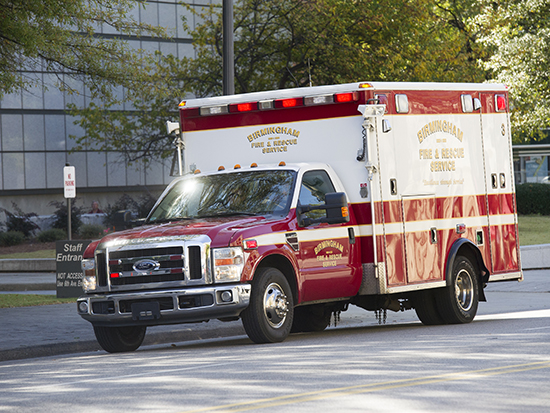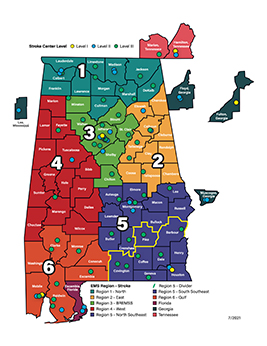 The Alabama Department of Public Health and the University of Alabama at Birmingham are in the midst of a multi-year project to enhance the statewide stroke response system and are now letting other states know how to follow their lead and build their own.
The Alabama Department of Public Health and the University of Alabama at Birmingham are in the midst of a multi-year project to enhance the statewide stroke response system and are now letting other states know how to follow their lead and build their own.
The Trauma Communications Center Coordinated Severity-Based Stroke Triage project is funded by a $2.5 million, five-year grant to UAB from the National Institute of Neurological Disorders and Stroke, one of the National Institutes of Health. The Alabama Statewide Stroke System, based on Alabama’s successful trauma response system, is unique in the United States. In a paper published in December in Frontiers of Neurology, UAB researchers have laid out their progress thus far in an effort not only to improve on Alabama’s stroke response, but to demonstrate to others how to go about it.
“Alabama is ahead of other states in this arena, especially in stroke research,” said Toby Gropen, M.D., the James H. Halsey Jr., M.D., Endowed Professor in the Department of Neurology and director of the UAB Comprehensive Neurovascular and Stroke Center. “The project builds on the outstanding Alabama Trauma System, using that infrastructure and the lessons learned in its creation, to build a similar system to improve stroke care in the state.”
The Alabama Trauma System utilizes the Trauma Communications Center, a statewide system that constantly monitors the status of every trauma hospital in the state, allowing patients to be routed to the most appropriate facility. The Alabama Statewide Stroke System also utilizes the TCC to provide early recognition and routing of patients with stroke symptoms to the most appropriate stroke center. The Trauma Communications Center was created in 1996 by Birmingham Regional EMS System to coordinate the routing of severely injured trauma patients to the most appropriate hospital and has since grown to include a stroke system and STEMI system, regionally and across Alabama.
“It has taken a lot of steps to get to where we are now,” Gropen said. “We have trained EMS providers across the state in a stroke severity scale and updated data collection so that we can measure and track patients, including transfers.”
 This map shows the location of stroke centers in Alabama and adjoining areas. The system coordinates with each of the six EMS regions in Alabama to provide each patient with the right care, at the right place, at the right time. Currently, EMS crews take suspected stroke patients to the nearest stroke center. As the statewide stroke system matures, EMS providers, working with the TCC, will be better able to triage a stroke patient to the most appropriate facility, whether that is the closest hospital or a more advanced stroke center. In some circumstances, patients may be initially triaged to the nearest stroke center and then transferred to a higher-level center.
This map shows the location of stroke centers in Alabama and adjoining areas. The system coordinates with each of the six EMS regions in Alabama to provide each patient with the right care, at the right place, at the right time. Currently, EMS crews take suspected stroke patients to the nearest stroke center. As the statewide stroke system matures, EMS providers, working with the TCC, will be better able to triage a stroke patient to the most appropriate facility, whether that is the closest hospital or a more advanced stroke center. In some circumstances, patients may be initially triaged to the nearest stroke center and then transferred to a higher-level center.
In all cases, the project coordinates the care provided to patients with severe stroke, and importantly, the project works with regional EMS directors and providers, along with hospitals throughout Alabama, to tailor the local implementation to the needs of each region.
Gropen says there are multiple levels of stroke centers in Alabama. Comprehensive stroke centers, such as UAB, provide the highest level of care and conduct research. There are only three comprehensive stroke centers in Alabama.
In order to improve access to mechanical thrombectomy, the ADPH is adding a new designation for thrombectomy-capable hospitals. Mechanical thrombectomy, not available in every hospital, is a treatment for stroke where an interventionist uses X-ray imaging to access and remove a blood clot in an artery. Widespread use of mechanical thrombectomy is credited in several studies with reducing deaths from strokes.
Primary stroke centers are able to provide t-PA therapy, an effective clot-busting drug when given within a few hours of a stroke, and stroke unit care. Primary stroke centers are able to meet the needs of most stroke patients. Acute stroke ready centers can provide emergency therapy including t-PA therapy and then generally transfer patients to higher-level facilities.
“Every one of these centers has an important role to play in the overall stroke response system,” Gropen said. “Just as we do with trauma, stroke patients are evaluated in the field and routed to the most appropriate facility. For example, some patients might be candidates for t-PA, which must be administered within four and a half hours of stroke onset. They may go to a closer hospital for that, and then be transferred to a more advanced center for additional treatment such as thrombectomy.”
Stroke is the fourth leading cause of death and the leading cause of disability in the United States. On average, someone has a stroke every 40 seconds in the United States, and someone dies from a stroke every four minutes. Gropen says the typical stroke patient will lose 2 million neurons every minute that a stroke is not treated.
“Our hope is that this project can turn into a road map for other states to do the same thing,” he said. “The need is there. We are in the middle of the stroke belt, which stretches across the entire Southeast. We believe this project will improve care and help reduce disparities in access to medical care. We will learn much that will help us drive the next steps to providing the best possible stroke care for residents of our state and region.”
